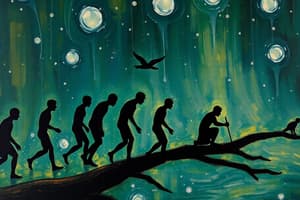Podcast
Questions and Answers
Which of the following is NOT one of Darwin's key observations related to natural selection?
Which of the following is NOT one of Darwin's key observations related to natural selection?
- Mutation (correct)
- Excess Reproduction
- Inheritance
- Variation
Natural selection leads to the gradual evolution of species.
Natural selection leads to the gradual evolution of species.
True (A)
What is meant by 'abiogenesis'?
What is meant by 'abiogenesis'?
The concept of life emerging from non-living matter.
The study of similar structures due to shared ancestry is known as ___________ structures.
The study of similar structures due to shared ancestry is known as ___________ structures.
Match the following structures with their descriptions:
Match the following structures with their descriptions:
Which of the following conditions is NOT required for the Hardy-Weinberg Principle to hold?
Which of the following conditions is NOT required for the Hardy-Weinberg Principle to hold?
Vestigial structures are always functional in current species.
Vestigial structures are always functional in current species.
What role does biogeography play in the study of evolution?
What role does biogeography play in the study of evolution?
Which type of selection favors average traits and reduces extremes?
Which type of selection favors average traits and reduces extremes?
Punctuated Equilibrium involves long periods of rapid evolutionary change.
Punctuated Equilibrium involves long periods of rapid evolutionary change.
What are the four principles of natural selection?
What are the four principles of natural selection?
The process of breeding for certain traits in agriculture is known as ________.
The process of breeding for certain traits in agriculture is known as ________.
Match the following terms with their definitions:
Match the following terms with their definitions:
What phenomenon describes the loss of genetic variation when a new population is established by a few individuals?
What phenomenon describes the loss of genetic variation when a new population is established by a few individuals?
Disruptive Selection favors average traits in a population.
Disruptive Selection favors average traits in a population.
Provide an example of a structure that serves no function but is a remnant of evolutionary history.
Provide an example of a structure that serves no function but is a remnant of evolutionary history.
_________ refers to the study of geographic distribution of species.
_________ refers to the study of geographic distribution of species.
What type of selection occurs when there is a shift in the population's trait distribution towards one extreme?
What type of selection occurs when there is a shift in the population's trait distribution towards one extreme?
Flashcards
Abiogenesis
Abiogenesis
The idea that life arose from non-living matter.
Speciation
Speciation
The process by which new species arise.
Microevolution
Microevolution
Small-scale evolutionary changes within a species or population over a few generations.
Homologous structures
Homologous structures
Signup and view all the flashcards
Vestigial structures
Vestigial structures
Signup and view all the flashcards
Analogous structures
Analogous structures
Signup and view all the flashcards
Hardy-Weinberg Principle
Hardy-Weinberg Principle
Signup and view all the flashcards
Speciation
Speciation
Signup and view all the flashcards
Natural Selection
Natural Selection
Signup and view all the flashcards
Stabilizing Selection
Stabilizing Selection
Signup and view all the flashcards
Directional Selection
Directional Selection
Signup and view all the flashcards
Disruptive Selection
Disruptive Selection
Signup and view all the flashcards
Gradualism
Gradualism
Signup and view all the flashcards
Punctuated Equilibrium
Punctuated Equilibrium
Signup and view all the flashcards
Biogeography
Biogeography
Signup and view all the flashcards
Study Notes
Darwin & Neo-Darwin's Theory of Evolution by Natural Selection
- Key Observations:
- Excess Reproduction: Species produce more offspring than can survive, leading to competition for resources.
- Variation: Individuals within a population exhibit differences.
- Inheritance (Adaptation): Traits are passed from parents to offspring.
- Differential Survival (descent with modification): Some variations increase survival and reproduction in specific environments.
- Theory Development:
- Darwin used observations from his voyage and other naturalists' work.
- Natural selection, over long periods, leads to speciation (new species formation).
- Three components of Darwinian and Neo-Darwinian theory:
- Abiogenesis: Life originating from non-living matter.
- Speciation (Macroevolution): Formation of new species.
- Microevolution: Small-scale evolutionary changes within a species over generations. Scientific evidence supports the occurrence of all three. Darwinian/Neo-Darwinian mechanisms currently only explain Microevolution.
Evidence of Evolution
- Fossils: Show changes in life forms over time.
- Structures:
- Homologous Structures: Similar structures, shared ancestry (e.g., vertebrate limbs).
- Vestigial Structures: Reduced or functionless parts, remnants of ancestors (e.g., human appendix).
- Analogous Structures: Similar function, different origin (e.g., bird and insect wings).
- Embryology: Similarities in embryonic development indicate common ancestry.
- Biochemistry: Similar proteins (e.g., cytochrome c) or DNA sequences in different species.
- Biogeography: Explains species distributions based on evolutionary history and geographic barriers.
- Natural Selection: Traits improving survival and reproduction become more prevalent in populations.
Shaping Evolutionary Theory
- Hardy-Weinberg Principle: Allele frequencies remain constant in a population under specific conditions (no mutation, gene flow, random mating, large population, no selection).
- Speciation: Divergence of populations into new species, often starting in small isolated populations with unique selection pressures.
- Types of Selection:
- Stabilizing: Favors average traits, reduces extremes.
- Directional: Favors one extreme trait, shifts population distribution.
- Disruptive: Favors both extremes, may lead to speciation.
- Models of Evolutionary Change:
- Gradualism: Slow, continuous evolutionary change.
- Punctuated Equilibrium: Periods of stasis punctuated by rapid change.
Natural Selection
- Four Principles:
- Overproduction of offspring: More offspring produced than can survive.
- Variation: Individuals within a population differ.
- Adaptation: Traits enhance survival and reproduction.
- Dissent with modification: Beneficial traits passed down.
- Conditions driving natural selection:
- Environmental changes (example given about peppered moths and industrial revolution)
- Predation (example with moths)
Vocabulary
- Artificial Selection: Breeding for desired traits.
- Natural Selection: Traits enhancing survival and reproduction.
- Evolution: Heritable trait changes in a population.
- Vestigial Structure: Reduced or non-functional structure.
- Homologous Structure: Similar anatomy, common ancestor.
- Analogous Structure: Similar function, different origin.
- Embryo: Early developmental stage, showing similarities.
- Biogeography: Study of species distribution.
- Fitness: Ability to survive and reproduce.
- Camouflage: Adaptation for blending into the environment.
- Mutation: Change in DNA sequence.
- Hardy-Weinberg Principle: Constant allele frequencies.
- Genetic Drift: Random allele frequency changes in small populations.
- Founder Effect: Reduced genetic variation in a new population.
- Bottleneck: Reduction in population size, diminishing genetic diversity.
- Stabilizing Selection: Favors average traits.
- Directional Selection: Favors an extreme trait.
- Disruptive Selection: Favors both extremes.
- Adaptive Radiation: Rapid diversification from a single ancestor.
- Gradualism: Steady, slow evolutionary change.
- Punctuated Equilibrium: Periods of stasis/rapid change.
- Irreducible Complexity: Argument that some biological systems cannot evolve through successive modifications.
Studying That Suits You
Use AI to generate personalized quizzes and flashcards to suit your learning preferences.




